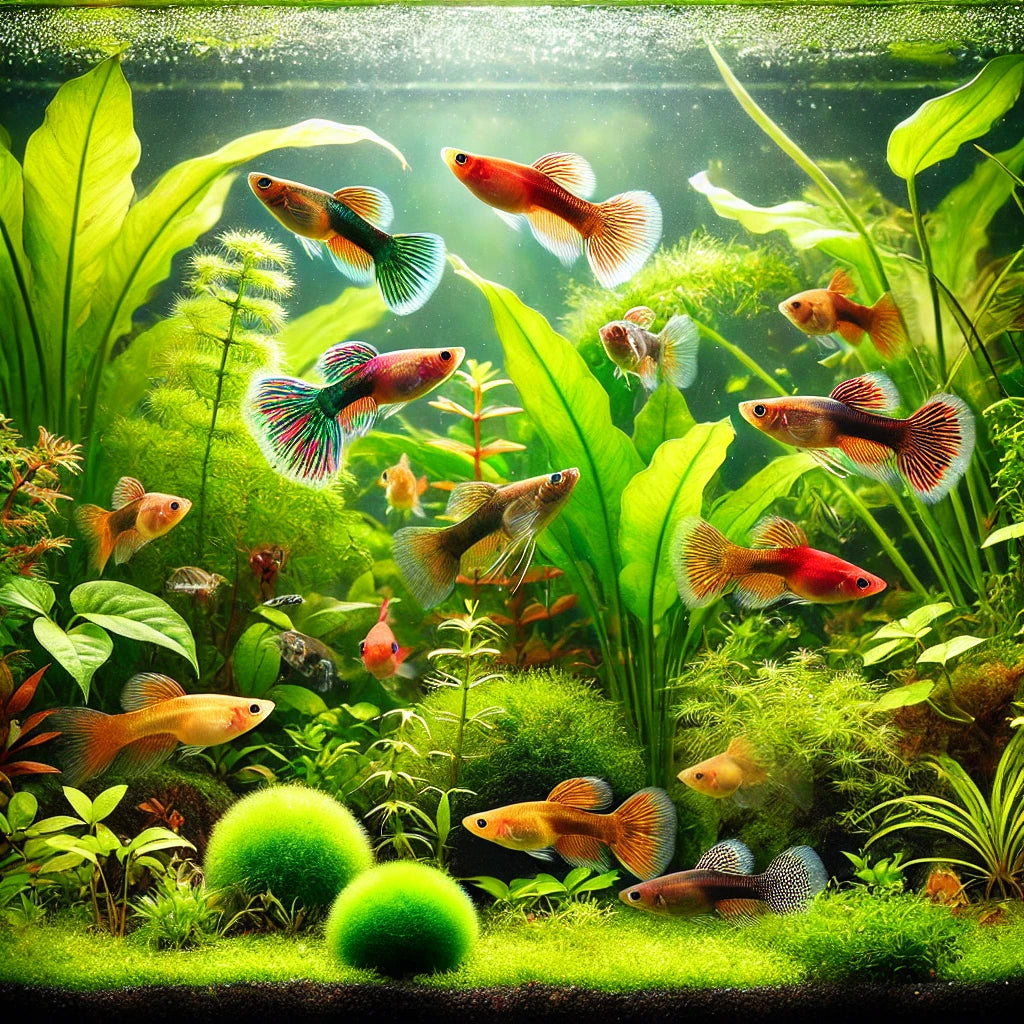Trending searches
Popular collections
Cart
$0

Guppies are one of the most beloved freshwater fish for aquarists worldwide. Known for their vibrant colors, playful behavior, and ease of care, these small livebearers are a perfect choice for both beginners and experienced fishkeepers. In this guide, we'll cover everything you need to know about guppy care—from setting up the right tank environment to feeding and breeding tips. And if you're looking for the best plants to complement your guppy tank, you can find a great selection at Aquarium Plants Factory to enhance your fish’s environment.
Guppies are not only beautiful but also hardy and adaptable, making them a great choice for a variety of aquarium setups. Their bright colors and active swimming patterns bring life to any tank. Plus, they are peaceful community fish that can coexist with many other species, provided that tank mates are chosen carefully.
While guppies are small fish (typically around 1.5 to 2 inches), they thrive in tanks of at least 10 gallons or larger. A larger tank is always better for maintaining stable water conditions and giving your guppies ample space to swim. Keep in mind that guppies are social fish, so it's best to keep them in groups.
Guppies are tropical fish that prefer warm water:
Invest in a reliable aquarium heater to maintain a stable temperature and a filter that provides gentle water flow, as guppies prefer calm water.
Guppies love a well-planted tank, so adding live plants like Anacharis, Java Moss, or Hornwort will not only make your aquarium look lush but also provide shelter and security for the fish. Aquarium Plants Factory offers a wide variety of live plants that will thrive in your guppy tank, enhancing both its aesthetic and functionality. Floating plants like Amazon Frogbit are also beneficial, as they mimic the natural habitat of guppies and help diffuse light.
Plants help improve water quality by absorbing excess nutrients and providing hiding places for fry if you plan to breed guppies. You can also add decorative elements like rocks, driftwood, and caves, but ensure there's plenty of open swimming space for the guppies.
Guppies are omnivores, meaning they eat both plant-based and animal-based foods. To ensure their health, provide a balanced diet that includes:
Feed your guppies small amounts 1-2 times daily, ensuring that they can consume all food within a few minutes. Overfeeding can lead to poor water quality and health issues.
Guppies are peaceful community fish, but choosing the right tank mates is important. Avoid pairing them with aggressive or large fish that might nip at their fins or outcompete them for food. Suitable tank mates include:
Adding plants from Aquarium Plants Factory can help create a more natural environment and provide places for these tank mates to hide and explore.
Guppies are livebearers, meaning they give birth to free-swimming fry rather than laying eggs. They are prolific breeders, and with the right conditions, breeding will often happen naturally.
To encourage breeding, ensure that you have a ratio of 1 male to 2-3 females. This helps reduce stress on the females, as males can be quite persistent during mating.
Provide plenty of hiding spaces with plants or breeding boxes to protect the pregnant females and, eventually, the fry. Live plants like Anubias, Cryptocoryne, or Java Fern from Aquarium Plants Factory are great options for this. Guppy fry are born fully formed and can be eaten by adults if not given places to hide.
Female guppies have a gestation period of about 21-30 days. You’ll notice a dark “gravid spot” near their rear, which indicates pregnancy. As the birth nears, the spot darkens, and the female's belly becomes more rounded. After giving birth, a single female guppy can release anywhere from 20 to 50 fry at a time.
If you want to increase fry survival rates, consider setting up a separate breeding tank or a breeder net within your main tank. Fry need a high-protein diet to grow quickly, so feed them crushed flakes, baby brine shrimp, or specialized fry food.
Make sure to maintain pristine water conditions in the breeding tank, as fry are more sensitive to poor water quality than adult guppies.
Guppies are generally hardy, but they can experience health problems if not properly cared for. Here are a few tips to ensure your guppies remain healthy:
Live plants not only enhance the beauty of your guppy tank but also create a more balanced ecosystem. By providing cover, reducing stress, and improving water quality, they contribute to the overall well-being of your fish.
For a variety of aquarium plants that will thrive in a guppy tank, check out the collection available at Aquarium Plants Factory. Whether you’re looking for foreground, background, or floating plants, you'll find high-quality options that will flourish in your aquarium.
Guppies are not just easy to care for—they’re also a joy to watch as they swim playfully around the tank, showing off their vibrant colors. By providing a comfortable environment, balanced diet, and good water conditions, you’ll ensure that your guppies thrive, breed, and brighten up your aquarium for years to come.
Add guppies and the right aquarium plants to your setup today to create a vibrant, thriving underwater world that you and your fish will enjoy! Happy fishkeeping!
!